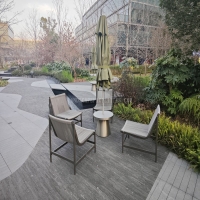Welcome to the website for landscape facilities products and knowledge.
How does the choice of countertop thickness impact the durability and aesthetics of a landscape bar counter?
The choice of countertop thickness is a critical decision in designing a landscape bar counter, profoundly influencing both its structural integrity and visual appeal. Far from being a mere detail, the slab's depth acts as the primary determinant of the counter's character, dictating how it withstands the elements and commands space in an outdoor setting.
The most direct impact of thickness is on durability. Thinner countertops, typically in the 2cm (¾ inch) range, are more susceptible to flexing and stress fractures, especially over long, unsupported spans common in bar counters. This vulnerability is exacerbated outdoors, where temperature fluctuations and potential ground settlement apply constant, unseen pressures. A thicker slab, such as 3cm (1-¼ inches) or even 4cm, possesses significantly greater structural mass. This inherent rigidity minimizes flex, reduces the risk of cracking from impact or stress, and provides a heftier, more permanent feel. For a landscape feature meant to last for decades, opting for a thicker countertop is a fundamental investment in longevity.
Aesthetically, thickness is a powerful design tool. A robust 3cm or 4cm slab presents a bold, substantial profile that conveys luxury, stability, and craftsmanship. This is particularly effective for modern or rustic designs where a strong, horizontal form is desired. The edge profile, where the thickness is most visible, becomes a key feature. Thicker slabs allow for more dramatic and intricate edge detailing, such as a full bullnose, a chiseled waterfall edge, or a sleek mitred corner, adding significant architectural interest. Conversely, a thinner 2cm countertop often requires a built-up edge (a laminated strip) to achieve a similar visual weight, a detail that can sometimes betray its construction method upon close inspection.
However, the decision is not without its trade-offs. Thicker countertops are substantially heavier, requiring a more robust and expertly engineered support structure, which can increase overall cost. They are also more expensive per square foot due to the greater material volume. Thinner slabs offer a lighter, sometimes more minimalist appearance and can be a cost-effective solution for tighter budgets, provided the support system is carefully planned to prevent deflection.
Ultimately, the optimal thickness balances practical and perceptual needs. For a high-use, permanent landscape bar counter exposed to the weather, the enhanced durability and premium aesthetic of a thicker slab (3cm or greater) are often worth the investment. It creates a resilient, commanding centerpiece built for both enduring function and timeless style.
Related search:

Recommendation
Metal structure rattan chair without armrests for single person, with woven seat and backrest.